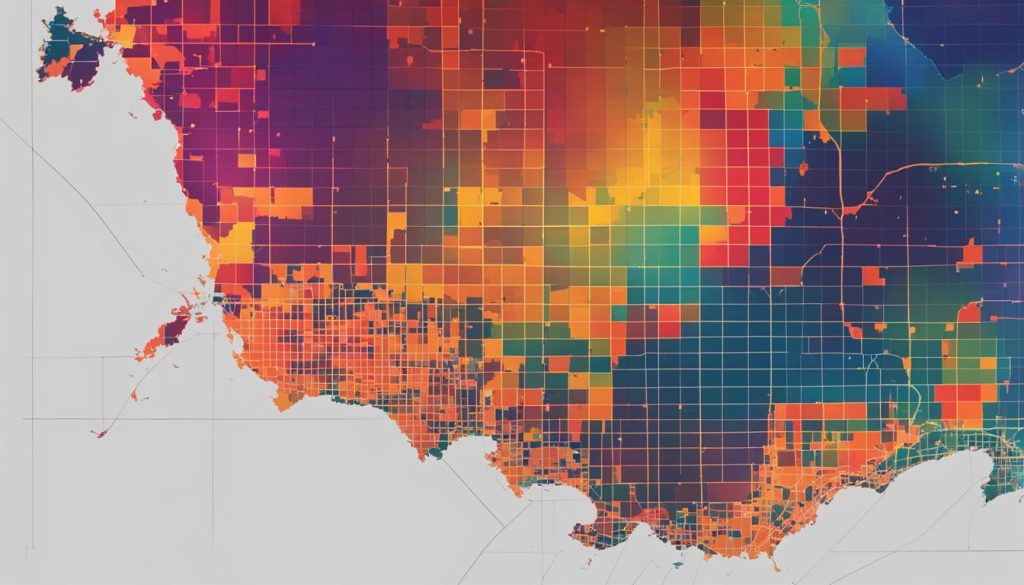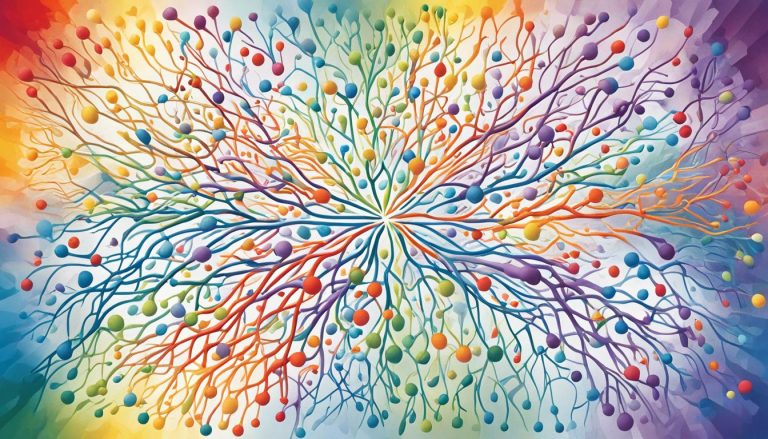Self-Organizing Maps (SOMs) are a powerful tool for visualizing complex, high-dimensional data sets. In an era of rapidly growing data, the need for effective data visualization techniques is paramount. SOMs offer a solution by preserving both global and local features of the data, enabling human inspection and interpretation.
High-dimensional data can be challenging to visualize due to the limitations of human perception. Traditional linear methods may result in the loss of important information. This is where SOMs shine, as they provide a non-linear approach to dimensionality reduction, allowing for more accurate and comprehensive visualization.
In this article, we will explore the concept of Self-Organizing Maps, their advantages in data visualization, and their applications across various fields. We will also delve into the methodology of using SOMs and the TMAP algorithm for handling large data sets. By leveraging the unique capabilities of SOMs, researchers and analysts can unlock hidden insights within high-dimensional data, leading to better decision-making and understanding of underlying data structures.
The Challenge of Visualizing High-Dimensional Data
Visualizing high-dimensional data presents significant challenges due to the limitations of human perception. When dealing with data that has a large number of dimensions, it becomes impractical to directly visualize each dimension. This is where dimensionality reduction techniques come into play.
In traditional linear methods like principal component analysis (PCA), the data is projected onto a lower-dimensional space. However, these methods may result in the loss of important information as they focus primarily on capturing the most significant dimensions.
Dimensionality reduction is crucial for effective visualization, as it allows us to transform high-dimensional data into a more manageable and visually understandable format. By reducing the number of dimensions while preserving the structure and relationships between the data points, we can gain valuable insights into the underlying patterns and trends.
The Complexity of High-Dimensional Data
High-dimensional data is inherently complex, making it challenging to visualize. Imagine a dataset with hundreds or even thousands of features or variables. Trying to visually represent each of these dimensions is practically impossible.
Moreover, our visual perception is limited to three dimensions (length, width, and depth). Attempting to visualize more than three dimensions becomes increasingly difficult for the human brain to comprehend.
The intricacy of high-dimensional data necessitates the use of dimensionality reduction techniques to transform the data into a lower-dimensional representation that is more amenable to visualization.
The Role of Non-Linear Methods
Non-linear dimensionality reduction methods, such as Self-Organizing Maps (SOMs), offer a solution to the challenges posed by visualizing high-dimensional data. Unlike linear methods, SOMs can capture complex relationships and non-linear structures in the data.
SOMs are a type of artificial neural network that uses an unsupervised learning algorithm to map high-dimensional data onto a low-dimensional grid. By assigning each data point to a specific grid node, SOMs preserve the topological relationships between data points, allowing for their effective visualization.
Visualizing high-dimensional data requires dimensionality reduction techniques like SOMs to overcome the limitations of human perception and capture the complexity of the data.
Using SOMs, we can visually explore the dataset, identify clusters, and discover patterns that might not be apparent in the original high-dimensional space. The ability to visualize these complex relationships makes SOMs a powerful tool for data exploration and analysis.
Next, let’s explore the characteristics and operation of Self-Organizing Maps in more detail.
Introducing Self-Organizing Maps
Self-Organizing Maps (SOMs), also known as Kohonen maps, are a type of artificial neural network specifically designed for data visualization.
Unlike traditional methods of dimensionality reduction, such as principal component analysis, SOMs offer a unique approach to visualizing high-dimensional data. They consist of an array of nodes, with each node representing a prototype or cluster in the data space.
SOMs utilize a competitive learning algorithm to map the complex high-dimensional data onto a low-dimensional grid. This grid preserves the topological relationships between data points, allowing for effective visualization and interpretation.
The competitive learning algorithm allows the SOM to adapt and self-organize, meaning it can learn from the patterns and structures in the data without requiring explicit supervision.
These neural networks excel at capturing both global and local features of the data, providing a holistic view of the underlying patterns. SOMs are particularly useful for identifying clusters, similarities, and anomalies within high-dimensional datasets.
By representing the data in a lower-dimensional space, SOMs simplify the visualization process without sacrificing essential information. They offer a powerful tool for exploring and understanding complex datasets, guiding data-driven decisions and fostering deeper insights.
Advantages of Using SOMs for Data Visualization
When it comes to visualizing high-dimensional data, Self-Organizing Maps (SOMs) offer several distinct advantages. These advantages make SOMs a valuable tool for data analysts and researchers in various domains. Let’s explore some of the key benefits of using SOMs for data visualization:
Comprehensive Representation of Data
SOMs have the ability to capture both global and local features of the data. This means that when visualizing high-dimensional data with SOMs, you can gain a more comprehensive understanding of the underlying patterns and structures. Unlike other dimensionality reduction techniques such as t-SNE or UMAP, SOMs provide a holistic representation that takes into account both the big picture and the finer details.
Preservation of Structure and Neighborhood Relationships
Another advantage of SOMs is their ability to preserve the structure and neighborhood relationships within the data. This allows for a more accurate exploration and interpretation of large datasets. By retaining the proximity of data points in the low-dimensional map, SOMs enable analysts to uncover meaningful clusters and associations that might not be immediately apparent in the original high-dimensional space.
Effective Visualization of Global and Local Features
With SOMs, you can visualize both the global and local features of the data simultaneously. The visual representation of global features provides an overview of the entire dataset, highlighting the main trends and patterns. At the same time, the visualization of local features allows for a closer examination of specific regions or clusters within the data. This dual perspective enhances the understanding of complex datasets and facilitates deeper insights.
To illustrate the advantages of using SOMs for data visualization, consider the following table that compares SOMs with other dimensionality reduction techniques:
| Advantages | SOMs | t-SNE | UMAP |
|---|---|---|---|
| Comprehensive Representation | ✓ | – | – |
| Preservation of Structure | ✓ | ✓ | ✓ |
| Visualization of Global Features | ✓ | ✓ | ✓ |
| Visualization of Local Features | ✓ | – | – |
This comparative table clearly demonstrates the advantages offered by SOMs in terms of providing a comprehensive representation, preserving the structure of the data, and visualizing both global and local features. While t-SNE and UMAP have their own strengths, they may not capture the complete picture that SOMs offer for data visualization.
By leveraging the unique capabilities of SOMs, researchers and analysts can effectively explore and interpret high-dimensional datasets, unlocking valuable insights and facilitating informed decision-making. Next, let’s delve into some real-world applications of SOMs in data visualization.

Applications of SOMs in Data Visualization
Self-Organizing Maps (SOMs) have a wide range of applications in data visualization across various fields. These powerful tools have been successfully employed in chemistry, biology, particle physics, and literature data, enabling researchers to explore and interpret complex datasets in a more intuitive and insightful manner.
Chemistry Data
SOMs have proved invaluable in visualizing large databases of molecules in chemistry. For instance, they have been extensively used to map chemical compounds and their properties in databases such as ChEMBL and DSSTox. By organizing and clustering molecules based on their structural similarities, SOMs facilitate the identification of patterns and trends, aiding researchers in drug discovery, material design, and other chemical research endeavors.
Biology Data
In the field of biology, SOMs have shown great promise in visualizing complex biological datasets. They help researchers analyze genomic data, gene expression patterns, and protein structures. By representing high-dimensional biological data in a lower-dimensional space, SOMs enable biologists to gain insights into the relationships between genes, proteins, and other biological entities. This allows for a deeper understanding of biological systems and can lead to the discovery of novel correlations and biomarkers.
Particle Physics Data
SOMs have also found applications in visualizing particle physics data, where large datasets are generated from experiments and simulations. These maps assist physicists in identifying patterns, anomalies, and new particles within the data. By organizing the data in a two-dimensional grid, SOMs highlight the relationships and interactions between particles, providing a valuable tool for data analysis and hypothesis generation.
SOMs in particle physics offer a unique perspective on understanding the subatomic world and uncovering the fundamental building blocks of the universe.
Literature Data
In the realm of literature, SOMs have been utilized to explore and analyze large collections of text and documents. By organizing textual data based on semantic similarities, SOMs enable researchers to uncover hidden topics, trends, and connections within the literature. This can have applications in fields such as information retrieval, recommendation systems, and sentiment analysis, allowing for more efficient navigation and understanding of vast amounts of textual information.
Overall, the applications of SOMs in data visualization transcend disciplinary boundaries. Their ability to capture and represent complex relationships within high-dimensional data make them a valuable tool in various domains, enabling researchers to gain deeper insights and make informed decisions based on the visualized data.

Methodology of Using SOMs for Data Visualization
The process of using Self-Organizing Maps (SOMs) for data visualization involves a systematic methodology that enables researchers and analysts to gain valuable insights from complex, high-dimensional data sets. One prominent algorithm used in this methodology is the TMAP algorithm, which stands for Tree-like MAPS. The TMAP algorithm allows for the representation of large, high-dimensional data sets as a two-dimensional tree structure.
By utilizing the TMAP algorithm, data visualizations based on SOMs take on a tree-like representation, which offers several benefits in the exploration and interpretation of large datasets. The tree-like nature of TMAP visualizations allows for the preservation of neighborhood relationships and overall structure, facilitating a deeper understanding of complex data patterns.
The TMAP algorithm’s transparency is another advantage, as it enables researchers to comprehend and interpret the underlying methods used to create the visualizations. This transparency promotes trust and confidence in the results, allowing for more informed decision-making based on the visualization outcomes.
Large data sets pose a unique challenge in data visualization due to their size and complexity. However, with the methodology of using SOMs and the TMAP algorithm, researchers and analysts can effectively overcome these challenges and unlock valuable insights from large data sets.
Steps in the Methodology:
- Preprocessing: Before applying SOMs and the TMAP algorithm, it is crucial to preprocess the data by cleaning and organizing it in a suitable format for analysis.
- Training the SOM: The next step involves training a SOM using the high-dimensional data set. During the training process, the SOM learns the underlying patterns and clusters within the data, resulting in a trained SOM model.
- Applying the TMAP Algorithm: Once the SOM is trained, the TMAP algorithm is applied to transform the high-dimensional data into a two-dimensional tree-like representation. This representation captures the topological relationships of the data points.
- Visualization and Interpretation: The final step is to visualize the transformed data using the TMAP-based visualization. Researchers and analysts can explore the visualization, gaining insights into the structure, relationships, and patterns present in the data. This visualization facilitates interpretation and supports decision-making based on a comprehensive understanding of the data.
Overall, the methodology of using SOMs for data visualization, specifically with the TMAP algorithm, provides a robust framework for analyzing and interpreting large, high-dimensional data sets. By leveraging the advantages of tree-like representations, increased neighborhood preservation, and transparency, researchers can effectively explore complex data and extract meaningful insights that drive informed decision-making.
Comparison of SOM Methodology and Traditional Techniques
| SOM Methodology | Traditional Techniques | |
|---|---|---|
| Dimensionality Reduction | Non-linear reduction through SOMs | Linear reduction through techniques like PCA |
| Visual Representation | TMAP-based tree-like representation | Flat, linear representation |
| Neighborhood Preservation | Preserves neighborhood relationships | May result in loss of local context |
| Transparency | Transparent algorithm and visualization methods | May lack transparency in the methods utilized |
| Handling Large Data Sets | Efficient for large data sets | Challenging to scale for large data sets |
Conclusion
In conclusion, Self-Organizing Maps (SOMs) offer a powerful solution for visualizing high-dimensional data. With their unique capabilities, SOMs provide advantages over traditional dimensionality reduction techniques, such as PCA, t-SNE, or UMAP. By leveraging SOMs, researchers and analysts can effectively explore and interpret complex datasets, facilitating better decision-making and deeper understanding of the underlying data structures.
SOMs have found applications in various fields, including chemistry, biology, particle physics, and literature data. Their ability to capture both the global and local features of the data makes them invaluable in these domains. Whether visualizing large databases of molecules or analyzing biological data, SOMs enable researchers to uncover valuable insights that may otherwise remain hidden.
By preserving the structure and neighborhood relationships within high-dimensional data, SOMs create visualizations that allow for intuitive exploration and interpretation. This not only helps in data analysis but also supports the communication of complex findings to a wider audience. In the era of big data, where the volume and complexity of information continue to grow exponentially, the use of SOMs becomes increasingly important for effective high-dimensional data visualization.
FAQ
What are Self-Organizing Maps (SOMs) and how do they help in visualizing high-dimensional data?
Self-Organizing Maps (SOMs) are powerful tools for visualizing complex, high-dimensional data sets. They use a competitive learning algorithm to map high-dimensional data onto a low-dimensional grid, preserving the topological relationships between data points. SOMs help in visualizing high-dimensional data by capturing both global and local features of the data, allowing for effective human inspection and interpretation.
Why is visualizing high-dimensional data challenging and what are the limitations of human perception in this regard?
Visualizing high-dimensional data is challenging due to the limitations of human perception. The complexity of these datasets makes it difficult to directly visualize all dimensions, leading to the need for dimensionality reduction techniques. Traditional linear methods, such as principal component analysis, may result in the loss of important information. Non-linear methods like SOMs are used to overcome these limitations and achieve effective visualization of high-dimensional data.
Are Self-Organizing Maps known by any other names, and what exactly do they consist of?
Self-Organizing Maps are also known as Kohonen maps. They consist of an array of nodes, with each node representing a prototype or cluster in the data space. These maps use a competitive learning algorithm to preserve the topological relationships between data points and map high-dimensional data onto a low-dimensional grid.
What advantages do Self-Organizing Maps offer for visualizing high-dimensional data?
Self-Organizing Maps offer several advantages for visualizing high-dimensional data. They can capture both global and local features of the data, providing a more comprehensive representation compared to other dimensionality reduction techniques. SOMs also preserve the structure and neighborhood relationships within the data, allowing for better exploration and interpretation of large datasets.
In which fields have Self-Organizing Maps been applied for data visualization?
Self-Organizing Maps have found applications in various fields for data visualization. They have been successfully used in chemistry to visualize large databases of molecules, such as ChEMBL and DSSTox. SOMs have also been applied to biology, particle physics, and literature data, showcasing their broad applicability across different domains.
What is the methodology of using Self-Organizing Maps for data visualization?
One prominent algorithm in the methodology of using Self-Organizing Maps for data visualization is the TMAP algorithm. This algorithm represents large, high-dimensional data sets as a two-dimensional tree, resulting in visualizations that are better suited for the exploration and interpretation of large datasets. TMAP-based visualizations offer increased neighborhood and structure preservation, as well as transparency of the underlying methods.



















